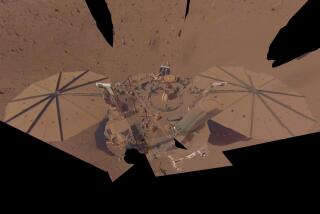Martian gully theory doesn’t hold water, study finds
In spite of the flowing gouges they leave behind, gullies on the Red Planet may not have been formed by liquid water, according to data from NASA’s Mars Reconnaissance Orbiter.
The findings, described in Geophysical Research Letters, showcase the complexity of Martian geology and highlight how some features on Mars are formed in ways that are unlike anything on Earth.
Scientists think that Mars, our rusty, dusty next-door neighbor, was once a far more Earthlike planet, with a thick atmosphere that could support puffy clouds, lakes of liquid water and perhaps even microbial life.
See the most-read stories in Science this hour »
All of that, if it indeed existed, is long gone now — but scientists can look for clues in the planet’s geography, finding physical and chemical signs that water once filled or flowed across a surface.
For example, NASA’s 2004 rovers Spirit and Opportunity, as well as the 2012 rover Curiosity, have all found evidence that ancient Mars must have been awash in water. Curiosity has even found chemical and mineral evidence for a long-lived series of lakes, along with signs of the right chemical ingredients for life.
So there seems to be a good amount of evidence that water once flowed across the Martian surface. There are even some hints that water may appear on the Red Planet’s surface today, in the form of dark streaks known as recurring slope lineae that grow and fade with the seasons. Scientists even recently announced that they may have evidence that highly briny water may occasionally make it to the surface.
The many gullies carved into many slopes on Mars, however, have remained a subject of debate. Certainly they look like they may have been formed by water, with an alcove at the top of the long gouge and a fan at the bottom, but scientists have also argued that they may be caused by dry ice – slabs of frozen carbon dioxide that slide down the slope thanks to a lubricating layer of sublimated CO2 gas, plowing through the terrain as they go.
The scientists have spotted white material around these gullies, but even that doesn’t settle the matter, said lead author Jorge Nuñez, a planetary scientist at Johns Hopkins University Applied Physics Laboratory.
“It could be water snow or it could be CO2 snow; we just don’t know,” he said. “So we felt that there could be some information that composition could provide to maybe help add a piece to the puzzle.”
In short, it’s hard to tell just by looking at an image. But water does interact chemically with rock that it comes into contact with — which means there might be a chemical signal left behind.
So for this paper, a team of scientists at Johns Hopkins University Applied Physics Laby used data from CRISM, the Compact Reconnaissance Imaging Spectrometer for Mars aboard NASA’s orbiter. CRISM can look at the fingerprint of light coming from a target to determine its chemical composition. The scientists figured they might find evidence of water – salts or maybe clays or other hydrated minerals — that would offer a solution to this long-standing mystery.
But when they looked at the data on more than 100 gully sites, they found no such chemical or mineral evidence. Most of the rock that wasn’t obscured by dust tended to be volcanic rock, largely unaltered by water. What clays they did find seemed to have been excavated by the sliding material rather than being created by it.
“So then it starts bringing the question: OK, if we’re not seeing any mineral evidence for liquid water, then what else could be doing this?” Nuñez said.
He said it lends further credence to the idea that the gullies might be gouged out by sliding blocks of carbon dioxide that later disappear. (Carbon dioxide is a very inert molecule and so doesn’t react chemically with rock as much as water does.)
But the scientists only looked at a hundred or so gully sites — so perhaps there are multiple forces at work, depending on where you look. More study will be needed to determine what exactly is happening in these gullies, and whether it’s truly ubiquitous across Mars.
“Mars is not a cookie-cutter planet of water or no water,” Nuñez said, “and it just goes on to show the complexity that there is on Mars. And obviously there’s still a lot that we don’t understand — yet.”
Follow @aminawrite on Twitter for more science news and “like” Los Angeles Times Science & Health on Facebook.
MORE IN SCIENCE
AI: NASA’s Curiosity rover can now choose its own targets on Mars
Dark matter eludes the world’s most sensitive detector: What’s next?
A hunt for dark matter in a former gold mine






